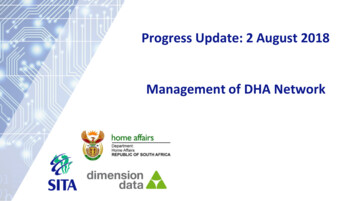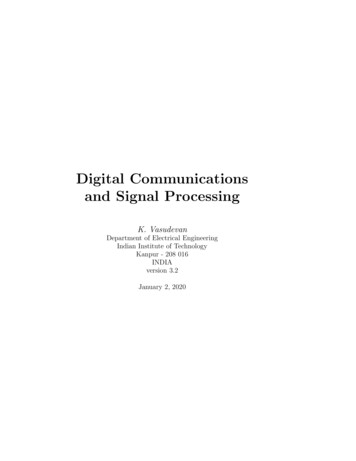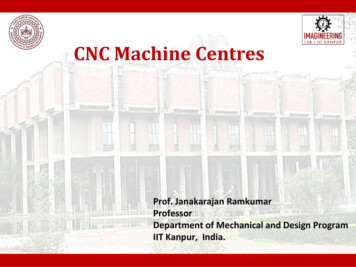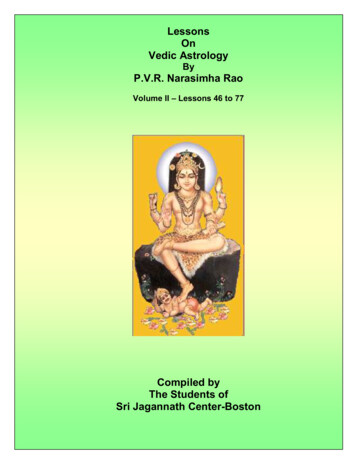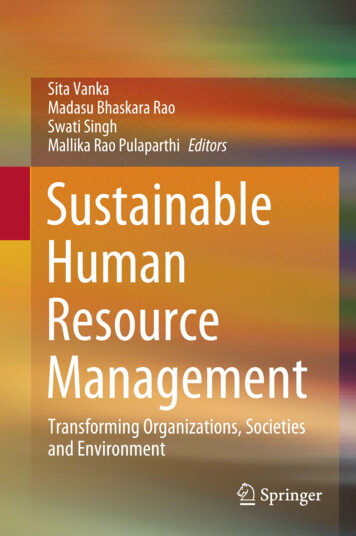
Transcription
Sita VankaMadasu Bhaskara RaoSwati SinghMallika Rao Pulaparthi ing Organizations, Societiesand Environment
Sustainable Human Resource Management
Sita Vanka Madasu Bhaskara RaoSwati Singh Mallika Rao Pulaparthi EditorsSustainable Human ResourceManagementTransforming Organizations, Societiesand Environment123
EditorsSita VankaSchool of Management StudiesUniversity of HyderabadHyderabad, Telangana, IndiaMadasu Bhaskara RaoICFAI Business SchoolICFAI Foundation for Higher EducationHyderabad, Telangana, IndiaSwati SinghSchool of Management StudiesUniversity of HyderabadHyderabad, Telangana, IndiaMallika Rao PulaparthiKL Business SchoolKoneru Lakshmaiah Education FoundationGuntur, Andhra Pradesh, IndiaISBN 978-981-15-5655-5ISBN 5-5656-2(eBook) Springer Nature Singapore Pte Ltd. 2020This work is subject to copyright. All rights are reserved by the Publisher, whether the whole or partof the material is concerned, specifically the rights of translation, reprinting, reuse of illustrations,recitation, broadcasting, reproduction on microfilms or in any other physical way, and transmissionor information storage and retrieval, electronic adaptation, computer software, or by similar or dissimilarmethodology now known or hereafter developed.The use of general descriptive names, registered names, trademarks, service marks, etc. in thispublication does not imply, even in the absence of a specific statement, that such names are exempt fromthe relevant protective laws and regulations and therefore free for general use.The publisher, the authors and the editors are safe to assume that the advice and information in thisbook are believed to be true and accurate at the date of publication. Neither the publisher nor theauthors or the editors give a warranty, expressed or implied, with respect to the material containedherein or for any errors or omissions that may have been made. The publisher remains neutral with regardto jurisdictional claims in published maps and institutional affiliations.This Springer imprint is published by the registered company Springer Nature Singapore Pte Ltd.The registered company address is: 152 Beach Road, #21-01/04 Gateway East, Singapore 189721,Singapore
PrefaceTraditional organizations were primarily driven by profit motive with the basicobjective of wealth maximization. The economic expansion was often equated withthe success of the organization. These organizations operated in the local/regionalmarket with limited players. The last three decades have witnessed a paradigm shiftin the way organizations conducted their operations. Many factors contributed to it,with Competition and performance culture among others, forcing organizations tolook beyond the traditional way of conducting their operations to sustain themselves. Thus, sustainability was brought into the center-stage of organizationalsurvival, renewal, growth and success. Worldwide policies and regulations, coupledwith national priorities, brought about a shift in the organizational scenario and theway they operated across the globe, so much so that they revisited their existingstrategies and attempted long term strategic planning to sustain their businesses.Sustainability as a concept was used predominantly in ecology meaning to endure.Applying the concept to business, it refers to sustainability in the endurance ofprocesses and systems. As organizations progressed, they were convinced thatprofits alone would not sustain an organization and hence, the people and planethave been added to the profit criterion through the Triple Bottom Line approach.Contemporary organizations acknowledge that sustainable development encompasses the environment, economic and societal issues and this was adopted as theprimary goal of every organization across the globe. The social dimension in TBLapproach received a further impetus with the mandated corporate social responsibility of organizations in 2001. Organizations were forced to not only work toimpact the society through fair trade practices, labor practices, human rights,employee safety and other social issues which impacted the stakeholders, but alsorequired to report through the sustainability reporting initiatives. Thus, sustainability reporting, although voluntary in many countries, was adopted for the manyadvantages perceived by organizations in terms of brand image, stakeholderengagement, shareholder satisfaction etc. Thus, people dimension was dominatedby CSR and society activities like greening. Studies on CSR revealed that organizations focused more on ecological and societal dimensions, sidelining humansustainability, thus, requiring scholars and practitioners alike to focus on the HRv
viPrefacefront. Termed as Sustainable HRM, this approach is still evolving with its dilemmas, dualities and paradoxes, which, according to Ehnert, still exist in the theoryand practice of sustainable HRM. Sustainable HRM is based the premise thathuman beings are ‘consumed’ and not ‘reproduced’. This is all the more critical fororganizations in the contemporary era where competent and skilled resources arescarce and there are consequent implications on health due to work, when there islong term exploitations of resources involved. Increased competition and performance culture are forcing organizations to provide a good work-life for theemployees while sustaining their businesses, with the result that scholars andpractitioners are now seeking possible solutions to the problem.Against this background, this book primarily aims at a compendium of scholarlyarticles and literature for professionals, scholars and researchers on issues relatingto sustainable HRM. More specifically, it includes the views of the experts from amulti-stakeholder perspective viz., policymakers, managers and academics onsustainable HRM, showcasing the research output in terms of models, perspectivesand frameworks, along with organizational initiatives and experiments conductedby managers in the field. The theme is contemporary and includes issues, perspectives, approaches, research studies/frameworks and emerging patterns relatingto sustainable HRM in a lucid way. The book provides an excellent opportunity forall those interested in updating their knowledge on the concept, processes, issues,and emerging paradigms on the theme from a multidimensional and cross-countryperspective.We place on record a deep sense of gratitude to a number of people, who havedirectly or indirectly helped in the completion of this volume. We acknowledge thecontribution of scores of people in our respective institutions—University ofHyderabad, India and IBS-Hyderabad, India, along with the authors of the scholarlypapers who have contributed their research/perspectives on the subject. Moreparticularly the help, effort, time and assistance of our research group, with specificmention of Rajendra Mahanandia, for their support is wholeheartedly acknowledged. The enduring support of our families has always enthused us to turn ourdreams into reality. We will be failing in our duty if we do not acknowledge thesupport of Ms. Nupoor Singh and her team of professional editors for their cooperation and excellent editing in the completion of this volume.Hyderabad, IndiaHyderabad, IndiaHyderabad, IndiaGuntur, IndiaDr. Sita VankaDr. Madasu Bhaskara RaoMs. Swati SinghMs. Mallika Rao Pulaparthi
Contents123456From Sustainability to Sustainable HRM—An EvolutionaryPerspective . . . . . . . . . . . . . . . . . . . . . . . . . . . . . . . . . . . . . . . . . . .Sita Vanka, Swati Singh, and Madasu Bhaskara Rao1Characteristics of Sustainable HRM System and Practicesfor Implementing Corporate Sustainability . . . . . . . . . . . . . . . . . . .Sugumar Mariappanadar9Sustainable Human Resource Management: Making HumanResources More Responsible . . . . . . . . . . . . . . . . . . . . . . . . . . . . . .Ekta Sarma and Madasu Bhaskara Rao37Incorporating Psychological Contract into the SustainableHRM Model . . . . . . . . . . . . . . . . . . . . . . . . . . . . . . . . . . . . . . . . . .Pattanee Susomrith57A Grounded Research Approach to Sustainable LeadershipPractices and Competencies . . . . . . . . . . . . . . . . . . . . . . . . . . . . . .Agna Fernandez, Francis David Kullu, and Ramesh Shankar71Sustainable HRM for Sustainable Careers of WomenProfessionals . . . . . . . . . . . . . . . . . . . . . . . . . . . . . . . . . . . . . . . . . .Swati Singh and Sita Vanka877Organizational Culture Dimensions as Drivers of EmployeeEngagement for Business Sustainability: Towards a ConceptualFramework . . . . . . . . . . . . . . . . . . . . . . . . . . . . . . . . . . . . . . . . . . . 109Shefali Nandan and Jyoti8Employer Branding and Employee-Emotional Bonding—TheCSR Way to Sustainable HRM . . . . . . . . . . . . . . . . . . . . . . . . . . . . 133Sunil Budhiraja and Satbir Yadavvii
viii9ContentsImpact of Sustainable Leadership on OrganizationalTransformation . . . . . . . . . . . . . . . . . . . . . . . . . . . . . . . . . . . . . . . . 151Madhurima Basu and Kumkum Mukherjee10 Culture, Climate and Sustainability in Organizations . . . . . . . . . . . 169Vinitha Nair and Veena Vohra11 Sustainable HRM Practices - A Drive Towards Sustainability(The case of NLCIL) . . . . . . . . . . . . . . . . . . . . . . . . . . . . . . . . . . . . 183R. K. Mishra and Shulagna Sarkar12 Effectiveness of an Emotional Intelligence Course in Enhancingand Sustaining the Emotional Competencies of MBA Students . . . . 197R. Deepa and K. Arulrajan13 Perceived Sustainability of Seasonal Employees on Destinationand Work—A Study in the Tourism Industry . . . . . . . . . . . . . . . . 213Rhulia Nukhu and Sapna Singh14 Sustainable Human Resource Management in the HospitalityIndustry: Evidence from Rajasthan . . . . . . . . . . . . . . . . . . . . . . . . 227Shaheema Hameed, Girish Nair, and Nidhi Choudhary15 Employee Engagement—A Driving Force for SustainingEmployees . . . . . . . . . . . . . . . . . . . . . . . . . . . . . . . . . . . . . . . . . . . . 247B. Aiswarya and G. Ramasundaram16 Examining the Role of HR Practice and Employee Engagementon Employee’s Loyalty—The Sustainability Dimensionsof Textile Industry in Bangladesh . . . . . . . . . . . . . . . . . . . . . . . . . . 259Salahuddin Ahmed and Sapna Singh17 Emotional Intelligence and Its Importance in SustainableDevelopment of Human Resources: A Conceptual Model . . . . . . . . 273Christabel Odame, Mrinalini Pandey, and Pramod Pathak18 The Green Road to Environmental Performance: A Studyof Private Banking Sector in Colombo District, Sri Lanka . . . . . . . 289P. N. Sandaruwan, U. K. Thalgaspitiya, and W. N. Hettiarachchi19 Sustainability and Sustainable HRM—Some Aspects . . . . . . . . . . . 307Sita Vanka, Swati Singh, and Madasu Bhaskara Rao
Editors and ContributorsAbout the EditorsDr. Sita Vanka is Professor and former Dean of the School of ManagementStudies, University of Hyderabad, India. She is a teacher, trainer, researcher andconsultant in the area of HRM, women’s studies and entrepreneurship. She serveson the board of two listed companies in Hyderabad. She has guided doctoralresearch, organized various workshops/conferences and published books/papers inHRM and sustainable HRM. She has received several awards for her research work.Further, she is a reviewer and has co-edited a special issue of Human ResourceManagement Review on sustainable HRM (Vol. 30(3), September 2020) and aspecial issue of Journal of Applied Research in Higher Education.Dr. Madasu Bhaskara Rao is Associate Professor at the Department of HRM &OB at ICFAI Business School, part of the ICFAI Foundation for HigherEducation, Hyderabad, India. He is the Coordinator of the ICFAI Staff Collegeand SWAYAM Program at the University. Prior to this, he held leadershippositions at K.L. University, the ICFAI National College and the corporate worldHe has authored books and has published in national/ international journals. Hehas organized several MDPs for Senior executives. Further, he is a Senior Editorof the Journal of Applied Research in Higher Education, and has co-editedspecial issue of Human Resource Management Review on sustainable HRM (Vol.30(3), September 2020) and a special issue of Journal of Applied Research inHigher Education.Swati Singh is Senior Research Fellow at the School of Management Studies,University of Hyderabad, India, and is pursuing her PhD on Sustainable Careers forWomen Professionals in the IT Sector. She is a recipient of a Junior ResearchFellowship from the University Grants Commission, India. She has reviewed andpublished papers in reputed journals and won 2 best paper awards in conferences.ix
xEditors and ContributorsShe is actively engaged in sustainability and sustainable development issues as apartner and volunteer in the Beyond Organic program by Deccan DevelopmentSociety, Hyderabad.Mallika Rao Pulaparthi is currently pursuing her PhD in HRM from the K.L.University, Vijayawada. She has published papers in reputed journals, has authoredbooks and is co-editing a special issue for both Journal of Applied Research inHigher Education and Employee Relations. Her research focuses on humanresource management and healthcare management.ContributorsSalahuddin Ahmed School of Management Studies, University of Hyderabad,Hyderabad, IndiaB. Aiswarya Loyola Institute of Business Administration, Chennai, IndiaK. Arulrajan PSG Institute of Management, Coimbatore, IndiaMadhurima Basu Indian Institute of Social Welfare & Business Management(Affiliated to the University of Calcutta), Kolkata, West Bengal, IndiaSunil Budhiraja SCMS, Nagpur, Symbiosis International (Deemed) University,Pune, Maharashtra, IndiaNidhi Choudhary Researcher, Faculty of Management Studies, Department ofCommerce and Management, Banasthali Vidyapith, Vanasthali, Rajasthan, IndiaR. Deepa PSG Institute of Management, Coimbatore, IndiaAgna Fernandez Loyola Institute of Business Administration, Chennai, IndiaShaheema Hameed Faculty of Management Studies, Department of Commerceand Management, Banasthali Vidyapith, Vanasthali, Rajasthan, IndiaW. N. Hettiarachchi Faculty, Department of HRM, University of SriJayewardenepura, Nugegoda, Sri LankaJyoti University of Allahabad, Prayagraj, IndiaFrancis David Kullu Loyola Institute of Business Administration, Chennai, IndiaSugumar Mariappanadar Peter Faber Business School, Australian CatholicUniversity, Melbourne, AustraliaR. K. Mishra Institute of Public Enterprise, Hyderabad, IndiaKumkum Mukherjee Indian Institute of Social Welfare & Business Management(Affiliated to the University of Calcutta), Kolkata, West Bengal, India
Editors and ContributorsxiGirish Nair Stenden University of Applied Sciences, Doha, QatarVinitha Nair School of Business Management, NMIMS, Mumbai, IndiaShefali Nandan University of Allahabad, Prayagraj, IndiaRhulia Nukhu School of Management Studies, University of Hyderabad,Hyderabad, IndiaChristabel Odame School of Management Studies, IIT-ISM, Dhanbad, IndiaMrinalini Pandey School of Management Studies, IIT-ISM, Dhanbad, IndiaPramod Pathak School of Management Studies, IIT-ISM, Dhanbad, IndiaG. Ramasundaram PSG Institute of Management Studies, Coimbatore, IndiaMadasu Bhaskara Rao ICFAI Business School, IFHE, ICFAI Foundation forHigher Education, Hyderabad, Telangana, IndiaP. N. Sandaruwan Faculty, DepartmentJayewardenepura, Nugegoda, Sri LankaofHRM,UniversityofSriShulagna Sarkar Institute of Public Enterprise, Hyderabad, IndiaEkta Sarma Ahmedabad University, Ahmedabad, Gujarat, IndiaRamesh Shankar Former CHRO Siemens & Chief Joy Officer, Hrishti, Mumbai,IndiaSapna Singh School of Management Studies, University of Hyderabad,Hyderabad, IndiaSwati Singh School of Management Studies, University of Hyderabad,Hyderabad, IndiaPattanee Susomrith School of Business and Law, Edith Cowan University,Joondalup, AustraliaU. K. Thalgaspitiya Faculty, Department of HRM, University of SriJayewardenepura, Nugegoda, Sri LankaSita Vanka School of Management Studies, University of Hyderabad, Hyderabad,IndiaVeena Vohra School of Business Management, NMIMS, Mumbai, IndiaSatbir Yadav Lovely Professional University, Phagwara, Punjab, India
Chapter 1From Sustainability to SustainableHRM—An Evolutionary PerspectiveSita Vanka, Swati Singh, and Madasu Bhaskara RaoAbstract Profound changes in climate on account of the destruction of nature alongwith its consequences on the health/well-being/unemployment leading to social andeconomic problems across the globe posed a serious challenge to both the organizations at the microlevel and the nations at the macrolevel. Effective managementof people by motivating them inculcates the performance culture which broughtin a renewed role for HRM for business sustainability and success. One of theresponses was seen in sustainable HRM making the human element at the centrestage of HRM activity. Linking sustainability to HRM also provided information onthe related issues of the Green HRM, socially responsible HRM, ethical HRM, etc.,thus categorizing the different strands of research into the first wave, second waveand third wave. This paper attempts to trace sustainable HRM from an evolutionaryperspective, by analysing the literature and presenting it in a descriptive format.Keywords Sustainability · Sustainable HRM · Evolution · ApproachesIntroductionFor long, humans have been consumers of various resources without replenishingthem. The continuance and the availability of resources, both natural and human, forsustainable living were not given due importance until recently. Only when seriousthreats were experienced due to unsustainable practices, the policymakers, scholarsand practitioners have started focusing on sustainable practices.Sustainability is considered an emerging discipline providing graduates insightsinto most aspects of the human world from business to technology to environmentand the social sciences. Sustainability is a broad and a multi-disciplinary domain.The employability for students/graduates requires core skills that would help themS. Vanka (B) · S. SinghSchool of Management Studies, University of Hyderabad, Hyderabad, Indiae-mail: vankasita@gmail.comM. B. RaoICFAI Business School, IFHE, Hyderabad, Telangana, India Springer Nature Singapore Pte Ltd. 2020S. Vanka et al. (eds.), Sustainable Human Resource -2 11
2S. Vanka et al.to work in a modern complex setting, which presupposes skills to drastically reduceemissions/discover/develop the technologies of the future for effective management.Sustainability draws heavily from social sciences and hard sciences as well. Sustainability skills and environmental awareness are a priority in many corporate jobs/startups complying with legislation globally. It is here that studies and practices assumesignificance for skill building and conceptualization on the subject.The definition of “sustainability” as the study of how natural systems function,remain diverse and produces everything it needs for the ecology to remain in balanceis acknowledged. It also acknowledges that human civilization uses resources tosustain the modern way of life. There are countless examples throughout humanhistory where a civilization has damaged its own environment and seriously affectedits own survival chances. According to Jared Diamond, an American geographer,historian and anthropologist, who argued that some countries developed more rapidlythan others and were able to expand because of their geography. The essence of histheory focused on the area of environmental history and the insights than can begained from large scale, long-term comparisons of how human societies around theglobe affect and are affected by their environments. He identified factors like climatechange, hostile neighbours, collapse of trading partners and environmental problemsas contributing to the collapse of societies. In summary, he attributed the collapse ofsocieties to their response to these four factors. Thus, environmental sustainabilitywas long before discussed by scholars (Diamond 2005). Sustainability also takes intoaccount how we might live in harmony with the natural world around us, protectingit from damage and destruction. In 2005, the World Summit on Social Developmentidentified three core areas that contributed to the philosophy and social science ofsustainable development. These “pillars” in many national standards and certificationschemes form the backbone of tackling the issues/core areas that the world now faces.The Brundtland Commission (1987) described it as a “development that meets theneeds of the present without compromising the ability of future generations to meettheir own needs”. The three pillars are economic development, social developmentand environmental protection. The economic development is a critical issue, with ahigh degree of disagreement because of the political ideology on economic growth.It has implication for businesses, jobs and employability. It also includes givingthe people what they want without compromising their quality of life, all the samereducing the financial burden for the government. Social development, on the otherhand, refers to the many facets—access to education, health, nutrition, safety forthe future of humanity in the context of technological development. Environmentalprotection refers to protecting the environment at home/business to protect frompotential damage that technology brings in the path of development.Profound changes in the climate and destruction of nature, income inequality,discrimination, poverty, corruption, low levels of education, health/well-being andunemployment, etc., pose a serious challenge to the society and economies acrossthe world. Global policy focused on the environmental hazards and its consequences on the planet and restricting the discourse on the sustainability to the labelplanet although Elkington proposed the ‘triple bottom line’—the planet, people andprofits—as the three elements of sustainability, long back in 1994.
1 From Sustainability to Sustainable HRM—An Evolutionary 3Businesses drive the economy and significantly contribute to sustainabilitythrough interaction among organizations, individuals, communities and governments. Business sustainability is the capability of a corporation to last in time interms of financial performance while efficiently managing environmental and socialassets. Businesses have to fulfil their responsibility to the society by willingly usingtheir resources for broad social needs and not simply for private interests of personsand firms. Business sustainability demands that earth’s capacity to produce vitalrenewable resources is maintained, restored and improved. Social good is a deliberate and purposeful action intended to benefit society. Businesses have to committo social good by contributing to sustainable development working with society atlarge, to improve the quality of life.Triple Bottom LineCompetition and performance culture forced even traditional organizations to recognize that profits alone cannot make them sustainable, rather focus on the ecologicaland social spheres of the organization along with the economic concerns, need attention. Thus, organizations started to emphasize people, planet and profits. Peoplerefer to the practices and policies relating to the employees like working environment, safety and security of employees, etc., in the organizations. Planet refers to theenvironmental practices creating little or no harm to the environment, while profitrelates to the economic value and wealth creation of the organization. Organizationshave recognized the importance of these three factors for sustainable development.Elkington (1994) refers this approach of balancing the three as Triple bottom line(TBL), often referred to as synonymous with sustainability. Organizations recognizedthe need to sustain their businesses in the long term and were forced to focus on peopleand planet. This being the challenge, measures to account for these two have becomethe focal point of organizational attention. While profits can be measured in terms ofthe growth in profits, calculating the environmental and societal performance of theorganization became a daunting task (Slaper and Hall 2010). Organizations wouldbe willing to invest time and money provided they are assured of commensuratereturn. Contemporary organizations have no choice other than to report and respondto the mandatory environmental and social impact in the changed environment. Thesignificance of appropriate measures in all the three spheres thus becomes important(Savitz and Weber 2006).TBL is an accounting framework to measure sustainability. It is consideredrevolutionary as it extended beyond profits to include environmental and societal performance. This framework is index-based, where each of the dimensionsdenoted by the variables gets determined by the stakeholders. The flexibility withwhich the organizational needs are met forms the important feature of this framework. Many of the MNCs have implemented the TBL for measuring the sustainability in their respective organizations (Dyllick and Hockerts 2002; Slaper and Hall2010). According to the KPMG Survey of Corporate Responsibility Reporting 2017,
4S. Vanka et al.Fig. 1.1 Triple bottom line. Source Elkington (1994)93% of the world’s largest 250 companies embraced reporting on TBL representinga significant increase of 35% in 1999 when KPMG first measured this metric(Retrieved from df/2017/10/kpmg/-survey-of). Each of the dimension is decisive, and this has been the definingfeature of this framework (Fig. 1.1).Global Sustainability Reporting InitiativesThe increasing customer awareness demands organizations to report its sustainableactivities. Governments, stock exchanges, markets, stakeholders, investors, shareholders and society have forced organizations to be more accountable and transparent(GRI 2014). On the other hand, organizations have shown willingness to voluntarilydisclose the economic, ecological and social performance (Wagner 2010). Such transparency in reporting the sustainability information helps the organization to buildtheir brand image and accountability to the general public (KPMG 2013). Althoughreporting is a channel to engage the stakeholders, there is no single measure that quantifies sustainability. The MNCs have accepted the TBL framework, but an authoritative and a comprehensive approach to measurement assumes significance. TheGlobal Reporting Initiatives (GRI) was introduced by United Nations EnvironmentProgramme (UNEP) in the year 1997, to develop reporting guidelines for the TBLwhich included social, economic and environmental performance, so as to establishsustainability reporting on par with financial reporting. The GRI guidelines are the
1 From Sustainability to Sustainable HRM—An Evolutionary 5most popular worldwide. According to the KPMG Report (2015), 74% of the world’s250 companies by revenue used the GRI guidelines. The DJSI is another frameworkwhich some companies use to report their information on sustainability. There arecountry-specific measures. The Business Responsibility Reporting (BRR) in India isone such example which provides nine principles on which the companies disclosetheir information on sustainability (SEBI 2012).Sustainable HRMResearch on HRM has developed in the last three decades, the key drivers beingperformance culture and the renewed role of HRM (Guest 2011). Empirical researchhas provided enough evidence on the role of HRM positively influencing performance (Huselid 1995), which later on was linked to the strategy and business success(Boxall 1996). However, organizations have been facing challenges of a differentorder relating to employee motivation, stress and the consequent health issues, worklife balance, etc. The response of HRM to such challenges was seen more in the natureof a renewed role in the organizations (Ulrich 1999). One of the responses was seen instrategic HRM, the inadequacy of which leads to the linking of sustainability to HRM.Sustainable HRM, as it is termed, made the human element as the corner stone of theHRM activity (Ehnert 2009). Linking sustainability to HRM provides informationon related issues like green HRM (Muller-Carmem et al. 2010), socially responsibleHRM (Shen and Jiuhua Zhu 2011; Diaz-Carrion et al. 2019) and also ethical HRM(Greenwood 2013) delineating the characteristics of sustainable HRM (Stankevičiūtėand Savanevičienė 2018) depending on the focus of the study (Stankeviciute andSavaneviciene 2013). Although the field of sustainable HRM is at a nascent stage,different strands of research have emerged and were categorized into first, secondand third waves of research by Kramar (2014). A more systematic conceptualization of sustainable HRM could be cited in recent work (Ehnert 2009; Ehnert et al.2016; Mariappanadar 2003, 2005, 2012, 2014; Kramar 2014; De Prins et al. 2015;Guerci et al. 2013). Extending the work of Wright and McMahan (1992) on strategicHRM framework, it was Ehnert (2009) who provided the initial understanding of theconcept. It was argued that the implication of sustainability in HRM practices raisescertain dilemmas and tensions, in view of the organizational demands of making theemployees available 24*7, thus affecting the work-life balance. It all the more getscomplicated with the interrelationships between HRM systems and business environment, thus effecting the human resources in the long term. Sustainable HRM helpsorganizations to develop and regenerate its human resources with the same speed withwhich they are consumed. The relevance of HRM impact in terms of externalities fordifferent stakeholders within and outside the organization is thus well
Madasu Bhaskara Rao ICFAI Business School ICFAI Foundation for Higher Education Hyderabad, Telangana, India Mallika Rao Pulaparthi KL Business School Koneru Lakshmaiah Education Foundation Guntur, Andhra Pradesh, India ISBN 978-981-15-5655-5 ISBN 978-981-15-5656-2 (eBook)
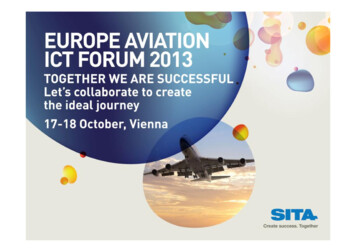
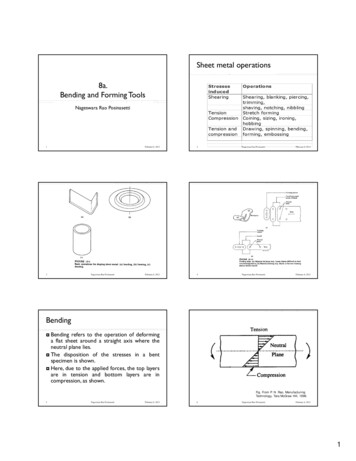
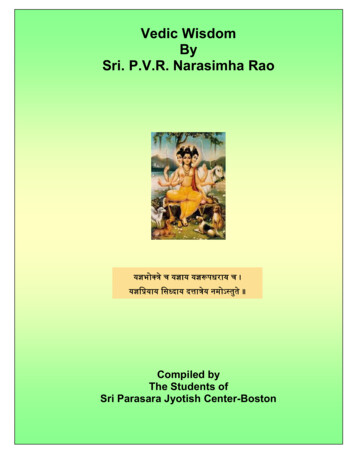

![INDEX [a3-usa ]](/img/30/sita-uv-web.jpg)
